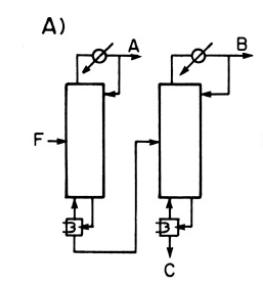Use Figure 11-6A (methanol product distillate from the first column, ethanol product distillate from the second column,
Question:
Use Figure 11-6A (methanol product distillate from the first column, ethanol product distillate from the second column, and 1-propanol product bottoms of second column) to purify a ternary feed. Feed mole fractions are methanol \(=0.2\), ethanol \(=0.5\), and 1 -propanol \(=0.3\). The feed is at \(75.0^{\circ} \mathrm{C}\), flow rate is \(1000.0 \mathrm{kmol} / \mathrm{h}\), and pressure is \(1.0 \mathrm{bar}\). Each product is \(99.0 \mathrm{~mol} \%\) or greater. Operate both columns at a constant pressure of 1.0 bar. Both columns have total condensers and kettle-type reboilers. Each column has only one feed. Column 1 has \(\mathrm{N}\) \((\) Aspen notation \()=40\). Column 2 has reflux ratio \(=2.0\).
Figure 11-6A

a. Which VLE correlation will you use? Briefly explain why you selected this correlation.
b. First, find any conditions that give methanol, ethanol, and 1propanol products that are all \(99.0 \mathrm{~mol} \%\) or greater. Report the conditions that worked: Column 1. Aspen \(\mathrm{N}=40\) (given), Aspen feed location \(=\) Operating condition 1 on Setup-Configuration tab _._.g., distillate flow rate) and value __ ; Operating condition 2 on Setup-Configuration tab and value
Column 2. Aspen \(\mathrm{N}=\ldots\), Aspen feed location \(=\) Operating condition 1 on Setup-Configuration tab (e.g., distillate flow rate) and value ___ ; reflux ratio \(=2.0\) (specified).
Results: Methanol mole fraction in methanol product ethanol mole fraction in ethanol product mole fraction in 1-propanol product \( \qquad \) \( \qquad \) , 1-propanol
c. Second, for column 1 , keep all variables except for reflux ratio and feed location constant. Find the optimum feed location for \(\mathrm{N}=40\). Then, with \(\mathrm{N}=40\) and the optimum feed stage, find the lowest reflux ratio that gives the methanol mole fraction within range 0.99000 to 0.99004 .
Report Column 1. Aspen \(\mathrm{N}=40\) (specified), Aspen optimum feed location \(=\) \( \qquad \) , reflux ratio \(=\) \( \qquad \) , methanol mole fraction in methanol product \( \qquad \) .
d. Third, the changes in column 1 may cause column 2 products to no longer meet specifications. If this is the case, find conditions that work, but keep reflux ratio \(=2.0\), and do not change column 1. If column 2 already meets specifications or once column 2 meets specifications, keep all variables except for \(\mathrm{N}\) and feed location constant. Find the optimum feed location. Reduce \(\mathrm{N}\) as much as possible while using optimum feed location and obtaining ethanol and 1-propanol product mole fractions that are greater than or equal to 0.99000 .
Report: Column 2. Aspen \(\mathrm{N}=\) \( \qquad \) , Aspen optimum feed location \(=\) , Operating condition 1 on Setup-Configuration tab (e.g., distillate flow rate) and value \( \qquad \) ; reflux ratio \(=\) 2.0. Ethanol mole fraction in ethanol product \( \qquad \) , 1-propanol mole fraction in 1-propanol product \( \qquad \) .
Step by Step Answer:

Separation Process Engineering Includes Mass Transfer Analysis
ISBN: 9780137468041
5th Edition
Authors: Phillip Wankat





